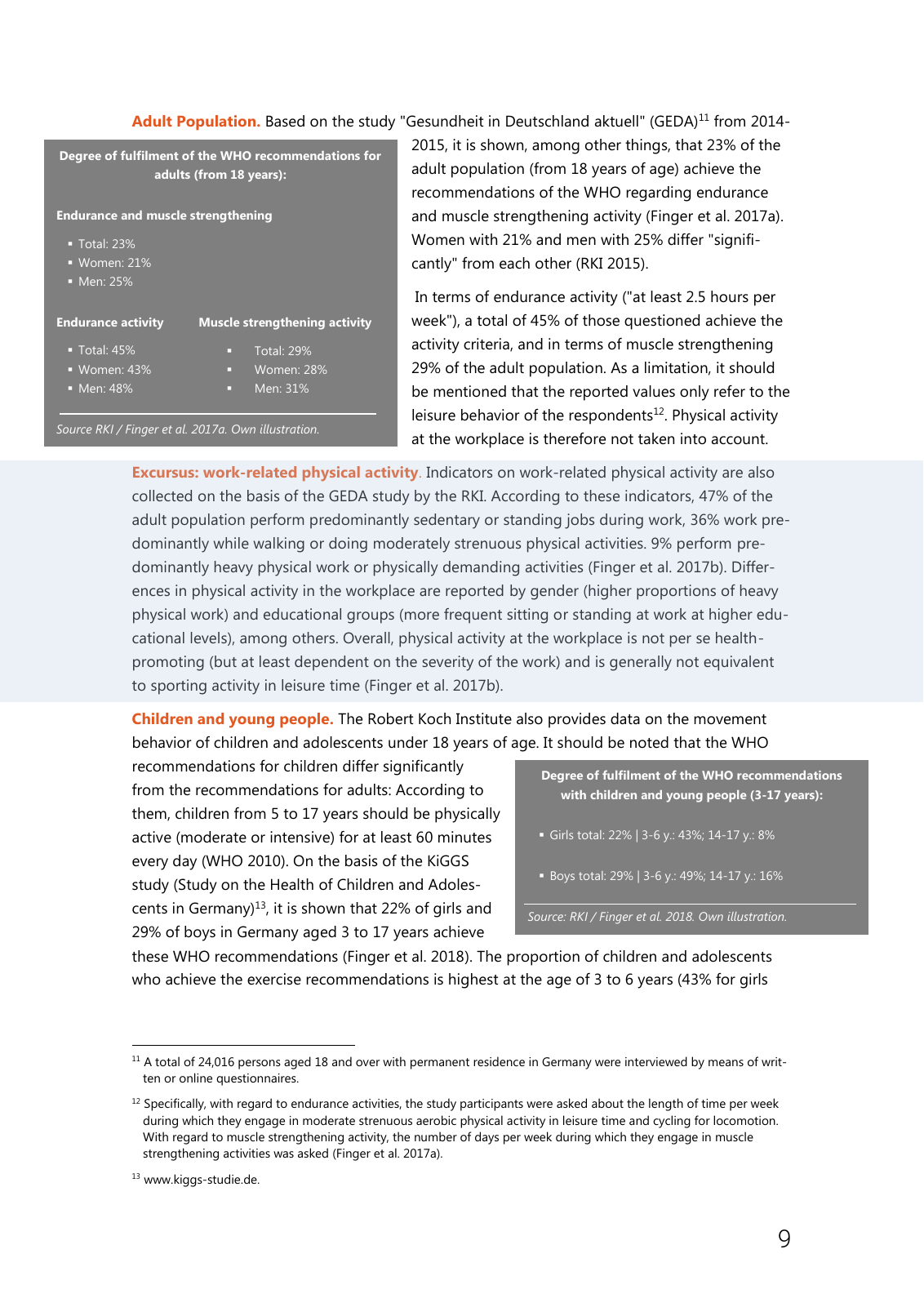9 Adult Population Based on the study Gesundheit in Deutschland aktuell GEDA 11 from 2014 2015 it is shown among other things that 23 of the adult population from 18 years of age achieve the recommendations of the WHO regarding endurance and muscle strengthening activity Finger et al 2017a Women with 21 and men with 25 differ signifi cantly from each other RKI 2015 In terms of endurance activity at least 2 5 hours per week a total of 45 of those questioned achieve the activity criteria and in terms of muscle strengthening 29 of the adult population As a limitation it should be mentioned that the reported values only refer to the leisure behavior of the respondents12 Physical activity at the workplace is therefore not taken into account Excursus work related physical activity Indicators on work related physical activity are also collected on the basis of the GEDA study by the RKI According to these indicators 47 of the adult population perform predominantly sedentary or standing jobs during work 36 work pre dominantly while walking or doing moderately strenuous physical activities 9 perform pre dominantly heavy physical work or physically demanding activities Finger et al 2017b Differ ences in physical activity in the workplace are reported by gender higher proportions of heavy physical work and educational groups more frequent sitting or standing at work at higher edu cational levels among others Overall physical activity at the workplace is not per se health promoting but at least dependent on the severity of the work and is generally not equivalent to sporting activity in leisure time Finger et al 2017b Children and young people The Robert Koch Institute also provides data on the movement behavior of children and adolescents under 18 years of age It should be noted that the WHO recommendations for children differ significantly from the recommendations for adults According to them children from 5 to 17 years should be physically active moderate or intensive for at least 60 minutes every day WHO 2010 On the basis of the KiGGS study Study on the Health of Children and Adoles cents in Germany 13 it is shown that 22 of girls and 29 of boys in Germany aged 3 to 17 years achieve these WHO recommendations Finger et al 2018 The proportion of children and adolescents who achieve the exercise recommendations is highest at the age of 3 to 6 years 43 for girls 11 A total of 24 016 persons aged 18 and over with permanent residence in Germany were interviewed by means of writ ten or online questionnaires 12 Specifically with regard to endurance activities the study participants were asked about the length of time per week during which they engage in moderate strenuous aerobic physical activity in leisure time and cycling for locomotion With regard to muscle strengthening activity the number of days per week during which they engage in muscle strengthening activities was asked Finger et al 2017a 13 www kiggs studie de Degree of fulfilment of the WHO recommendations with children and young people 3 17 years Girls total 22 3 6 y 43 14 17 y 8 Boys total 29 3 6 y 49 14 17 y 16 Source RKI Finger et al 2018 Own illustration Degree of fulfilment of the WHO recommendations for adults from 18 years Endurance and muscle strengthening Total 23 Women 21 Men 25 Endurance activity Total 45 Women 43 Men 48 Source RKI Finger et al 2017a Own illustration Muscle strengthening activity Total 29 Women 28 Men 31

Hinweis: Dies ist eine maschinenlesbare No-Flash Ansicht.
Klicken Sie hier um zur Online-Version zu gelangen.
Klicken Sie hier um zur Online-Version zu gelangen.